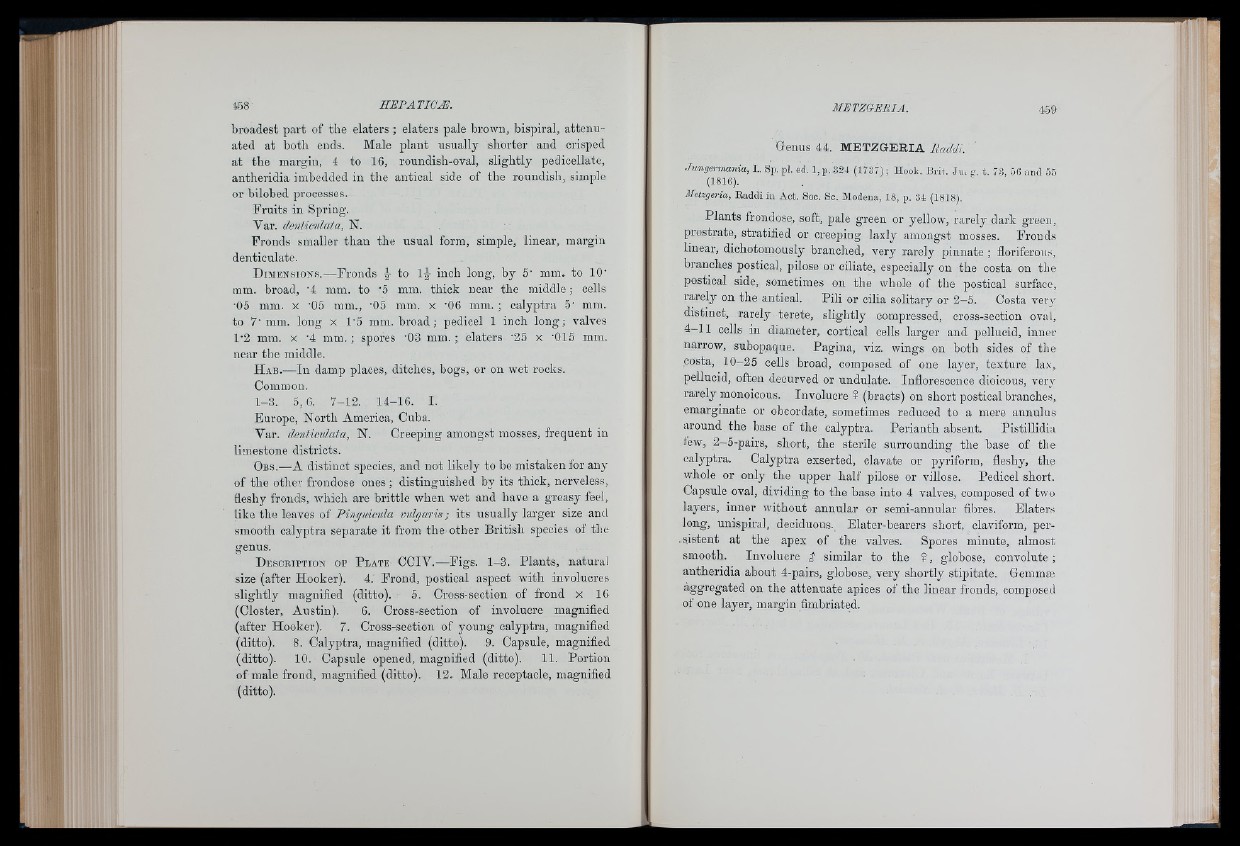
broadest part of the elaters ; elaters pale brown, bispiral, attenuated
at both ends. Male plant usually shorter and crisped
at the margin, 4 to 16, roundish-oval, slightly pedicellate,
antheridia imbedded in the antical side of the roundish, simple
or bilobed processes.
Fruits in Spring.
Var. denticulata, N.
Fronds smaller than the usual form, simple, linear, margin
denticulate.
D imensions.—Fronds J to inch long, by 5' mm. to 10’
inm. broad, '4 mm. to A mm. thick near the middle; cells
■05 mm. X '05 mm., "05 mm. x "06 mm. ; calyptra 5' mm.
to 7’ mm. long x 1'5 mm. broad; pedicel 1 inch long; valves
F2 mm. x '4 mm.; spores ’03 mm.; elaters '25 x '015 mm.
near tbe middle.
H ab.— In damp places, ditches, bogs, or on wet rooks.
Common.
1-3. 5,6. 7-12. 14-16. I.
Europe, North America, Cuba.
Var. denticidata, N. Creeping amongst mosses, frequent in
limestone districts.
Obs,— A distinct species, and not lik ely to he mistaken for any
o f the other frondose ones ; distinguished by its thick, nerveless,
fleshy fronds, which are brittle when wet and have a greasy feel,
like the leaves o f Pinguicida vidgaris; its usually larger size and
smooth calyptra separate it from the other British species o f the
genus.
D escription op P late CCIV.—Pigs. 1-3. Plants, natural
size (after Hooker). 4. Prond, postical aspect with involucres
slightly magnified (ditto). 5. Cross-section of frond x 16
(Closter, Austin). 6. Cross-seotion of involucre magnified
(after Hooker). 7. Cross-section of young calyptra, magnified
(ditto). 8. Calyptra, magnified (ditto). 9. Capsule, magnified
(ditto). 10. Capsule opened, magnified (ditto). 11. Portion
of male frond, magnified (ditto). 12. Male receptacle, magnified
(ditto).
Genus 44. METZGERIA Raddi.
./ungermania, L. .Sji. pi. ed. 1, p. 324 (1787); Hook. Ki-it. J i„ sr. t. 73, f.fi .-ind 55
(1816).
Metzgena, Raddi in Act. Soc. So. Modena, 18, p. 34 (1818).
Plants frondose, soft, pale green or yellow, rarely dark green,
prostrate, stratified or creeping laxly amongst mosses. Froud.s
linear, dichotomously branclied, very rarely pinnate ; floriferous,
branches postical, pilose or ciliate, especially on the costa on the
postical side, sometimes on the whole of the postical surface,
rarely on the antical. Pill or cilia solitary or 2—5. Costa very
distinct, rarefy terete, slightly compressed, oross-seotion oval,
4-11 cells ill diameter, cortical cells larger and pellucid, inner
narrow, suhopaque. Pagina, viz. wings on both sides of the
costa, 10-25 cells broad, composed of one layer, texture lax,
pellucid, often decurved or undulate. Inflorescence dioicous, verv
rarely monoicous. Involucre ¥ (bracts) on short postical branohes,
emarginate or obcordate, sometimes reduced to a mere annulus
around the base of the calyptra. Perianth absent. Pistillidia
tew, 2-5-pairs, short, the sterile surrounding the base of the
calyptra. Calyptra exserted, clavate or pyriform, fleshy, the
whole or only the upper half pilose or villose. Pedicel short.
Capsule oval, dividing to the base into 4 valves, composed of two
layers, inner without annular or semi-annular fibres. Elaters
long, unispiral, deciduous. Elater-bearers short, claviform, per-
• sistent at the apex of the valves. Spores minute, almost
smooth. Involucre $ similar to the ?, globose, convolute ;
antheridia about 4-pairs, globose, very shortly stipitate. Gemm®
aggregated on the attenuate apices of the linear fronds, composetl
of one layer, margin fimbriated.